Welcome to another episode of "Mento took way too many notes when playing a game and just dumps the whole .txt file on Giant Bomb's readership to sort out," also known as (by no-one) the Mento Discovery Series. La-Mulana 2 is the Kickstarter-funded 2018 sequel to fan-favorite explormer and sado-masochism simulator La-Mulana and very much follows in its footsteps as a deliberately tough, mean-spirited, and deeply obtuse dungeon-crawler presented in a throwback 2D pixel graphical style. However, rather than being based on Super Metroid or Castlevania: Symphony of the Night like most of its Indie peers it goes even further back to the likes of Knightmare II: The Maze of Galious or Legacy of the Wizard: the early MSX aesthetic is all over that first game, and even if its newer lavish 16-bit remake no longer has the scanlines or crisp CGA graphics then at least it pays tribute in a referential sense as it has all sorts of MSX apps for you to find and utilize for (mostly hidden) perks. The sequel brings that aspect back and many more cameos besides, and comes up with an excuse for why there's an entirely new dungeon full of malicious sapience to explore just adjacent to the old ruins of La-Mulana.
I wrote about La-Mulana 2 a few weeks ago but I'd only really scratched the surface of the game's content by the time I published that review, not yet plumbing the game's deeper waters. Turns out it has layers upon layers of obfuscation, starting with its very lore-heavy approach to world-building and how the player is intended to integrate their understanding of the dungeon's backstory and that of its dozens of inhabitants with their approach to the multitude of overarching puzzles that need solving to make forward progress. Tidbits and exposition dumps from the NPCs you meet and the stone tablets you find while exploring actually have meaning - not just in the sense of establishing a rich universe of fiction based loosely on the mythology of several different global cultures but in how these clues are often very relevant to a specific conundrum you'll eventually need to overcome, possibly many more hours further down the line. I was lax in taking notes on absolutely everything and I soon paid that price. And to think, La-Mulana 2 was built to be considerably more neophyte-friendly than its predecessor.
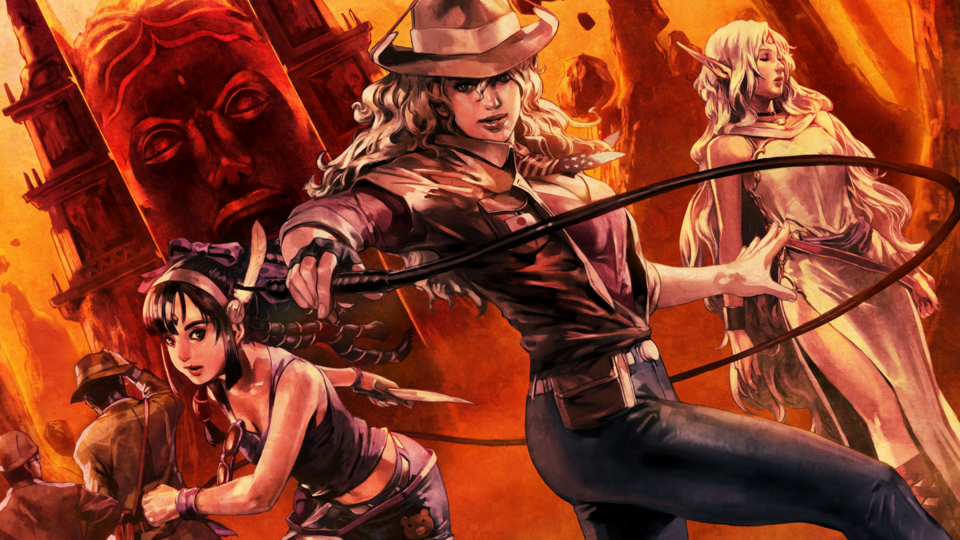
If you take away nothing else from the subsequent thousands of words of incoherent rambling about Sky People and mantras, remember the lesson of writing down or recording everything you hear when playing La-Mulana 2 (and the first La-Mulana too, I'd imagine) and not deleting any of it until you're certain you've resolved whatever obstacles they are referencing. Even the skeleton calling you a dumbass is probably onto something.
(A warning here for moderate-to-major spoilers for all of La-Mulana 1 and 2 throughout - if you want the spoiler-free version of my thoughts, that review above is still mostly applicable.)
All right, I've dawdled enough outside this whirlpool of madness, so let's start spiralling into it already:
What is La-Mulana?
La-Mulana is a sprawling complex filled with architecture from multiple past civilizations situated close to and under an isolated village deep in an unknown jungle. In the first game, adventurer archaeologist Lemeza Kosugi followed a tip left by his father (and unrepentant glory thief, turns out) that the ruins held the origin of all life on Earth. Stuff happened, and as of La-Mulana 2 the ruins are a lifeless and mostly impassable wreck.
OK, but what is it really?
The origin of life thing turned out to be accurate in a way no-one could have foreseen: the ruins themselves comprise the body of a colossal alien lifeform that crashed into the Earth in the prehistory of civilization and created entire species of intelligent humanoid life in order to help it return to the stars. This entity, known only as "Mother," would regularly destroy her own offspring if they proved unfit to the task of launching her back into space, starting over with a new sapient race of workers. Humanity is simply the last of these "Children" races, though due to some trickery from the preceding races they are also the first to not have a RoboCop-style compulsion hard-coded into their DNA that forces them to work for Mother's sake and makes it nigh-impossible to defy her. A member of this race, Lemeza, successfully stood against Mother and destroyed her soul, rendering the resulting shell unable to support its own complex inner workings and subsequently collapsing from the strain.
All those other Child races are what we would consider to be demi-gods and mythological beings, though closer to angels in the sense that they were all (nearly) immortal creatures devoid of free will compelled to do the bidding of an all-powerful deity. Humanity, designed to be short-lived and curious, are the eighth such race to originate from Mother, and are therefore known as the 8th Children. It's some very Evangelion shit.
What is Eg-Lana?
Beyond a contrived means to have a sequel when the all-encompassing antagonist of the previous game has already been slain, Eg-Lana is a dark mirror of La-Mulana created by the Mother as a back-up in case something happened to her original form. Originally devoid of the life energy that coursed through La-Mulana from Mother and powered all its traps and mechanisms, the silent and dark Eg-Lana was considered a dumping ground for the more warlike and rebellious members of previous Child races where they could fight amongst themselves far away from where Mother's work was being done. After Mother's defeat, it has suddenly sprung to life and has proven to be even more dangerous and difficult to navigate than La-Mulana, not least of which due to the ever-warring members of the Child races that still dwell there.
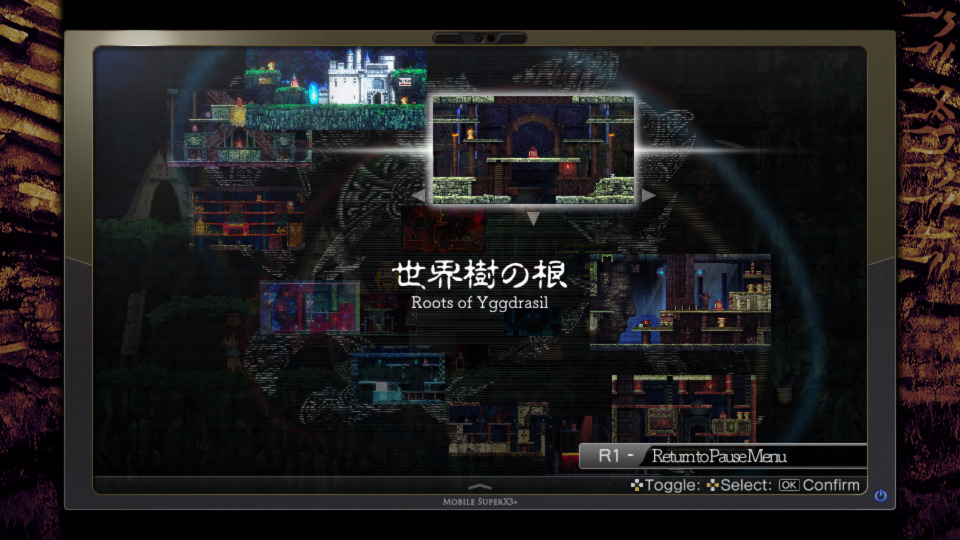
Eg-Lana itself is structured like an upside-down tree; the Norse tree of life, Yggdrasil, specifically. That means you enter somewhere near the roots and work outwards and downwards towards the branches and treetop. I never got this impression while playing - the dungeon "floors" are all connected in odd ways - but if you were able to visualize it in your head while playing certain clues referring to locations at the very top or bottom of the tree would be easier to follow.
Who are the other Children?
Each Child race is a different variation of intelligent life, built to be hard-working and obedient but granted enough intelligence to solve any issues that might arise when delivering Mother to space. Those given too little intelligence were unable to solve these issues and destroyed for their incompetence, while those granted too much realized the precariousness of their continued existence and endeavored to defy Mother's will, either directly or in secret, and were subsequently destroyed for their dissention.
- The 1st Children, a race that resembled humans with snake-like lower-halves, represented the old gods of the Japanese shinto religion and their mythology. Members include: Izanagi, Kami-musubi, Amenotokotachi.
- The 2nd Children, the giants that would go on to inspire Mayan mythology, were brilliant architects and laborers that ended up wiping each other out in a brutal, ideological civil war. Members include: Sakit, Leda, Mnemosyne.
- The 3rd Children, the winged Olympians who inspired the Greek pantheon, saw a contingent break away from their mild-mannered kin that dabbled in creating chimera with which to wage war. Members include: Hermes, Orpheus, Eurytus.
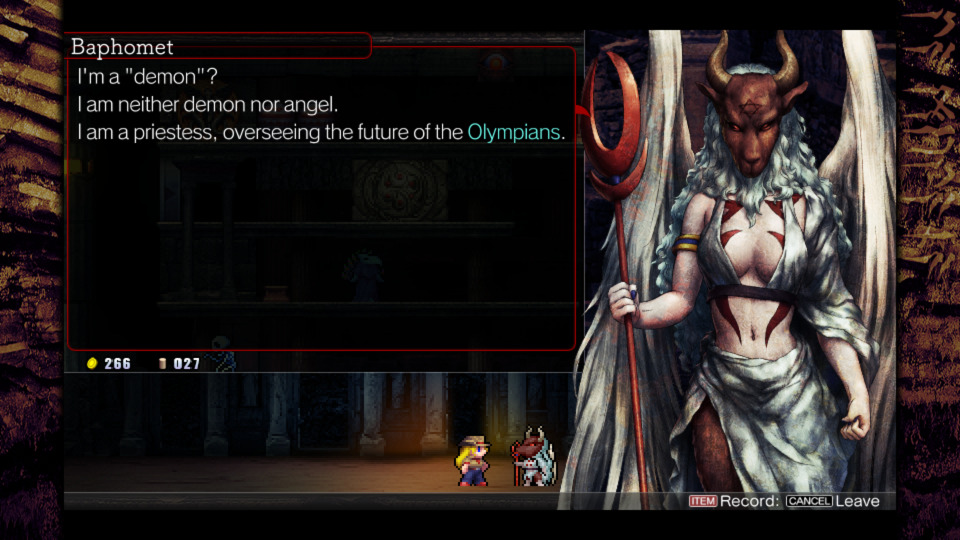
- The 4th Children, who were supposedly fish-like, were presumably not intelligent enough to keep records. None of their writings, if any exist at all, are present in La-Mulana or Eg-Lana.
- The 5th Children, which resemble the ancient Egyptian pantheon, were possessed of great intelligence and used it and knowledge taken from their predecessors, the 3rd Children, to build a machine that could create life for them. Mother co-opted it after eliminating them for their skulduggery. Members include: Ra, Isis, Horus.
- The 6th Children, of which there are multiple species based on Norse mythology and those of the fae folk of northern and western Europe, were originally crafted from clay given life by the machine of the 5th Children and as a result did not suffer the overpowering urge to serve Mother. Members include: Freya, Thor, Tyr.
- This lead to a group of the 6th Children, the wise Alfr, creating the 7th Children as a servile race that in secret were designed to be even more resistant to the Mother's dominant will. Members include: Mulbruk, Fobos, and every villager.
- The 7th Children escaped La-Mulana and eventually created their own race in turn, the 8th Children, who would be entirely free of Mother's influence and could live independently. Since Mother held no sway whatsoever over the 8th Children, one of them - Lemeza - was able to defeat her. Members include: About eight billion people.
The Seven (Biggest) Mysteries of Eg-Lana
The purpose behind establishing all this lore is so there's necessary context behind the following puzzles that occupy both a micro (just for one region) and macro (the whole game) role in how the player makes progress towards the end. La-Mulana 2 is relatively distinct in explormer circles for gating progress not just behind the usual traversal upgrades and exploring every available route on the map, but by having players comprehend its lore and clues sufficiently enough to tackle some of the dungeon's bigger mysteries, ascertain their solutions, and push forward with the new routes and items that result as rewards.
To effectively demonstrate how La-Mulana 2 operates, I've assembled seven of the biggest question marks you'll continue to piece together and decipher throughout the game.
1) The Prophecy of the Alfr Seeress
When exploring the earlier areas of the game, particularly The Roots of Yggdrasil (the very first area of Eg-Lana) and the fairy realm of Annwfn, you'll find multiple stone tablets of a slightly different shape that comprise five separate chapters of what seems like a poem, called the Alfr Seeress's Prophecy.
Way, way later towards the end-game when you're trying to access the Underworld - a very tough late-game area to reach, let alone navigate once inside - you'll get a notice from Freya, a friendly NPC that is the queen of the Alfr, that each of these Seeress tablets contain a secret message and will helpfully change the text of them (including the versions you've already recorded, conveniently) to point out trigger words. These words are actually part of the mantra language you pick up throughout the game: mantras being words of power within Eg-Lana that can have dramatic effects on certain screens, once you've learned how to invoke them and then learned the relevant mantras in question. The five parts of the Seeress Prophecy actually give you directions to multiple late-game uses of mantras, including one necessary for the final boss fight. Given the length of the game, however, there might be a fifty hour gap between the moment you first encounter these tablets and when you understand their message.
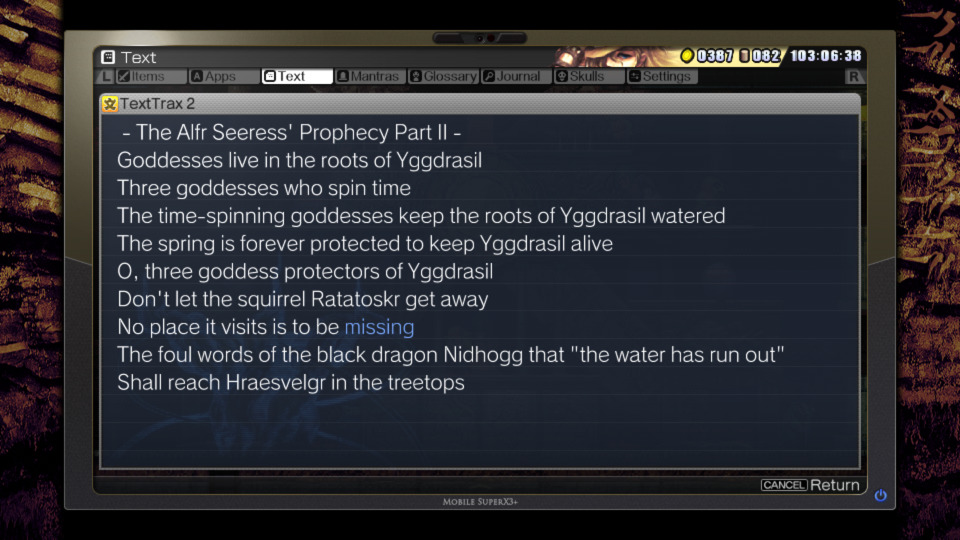
I love this idea, as it's the closest the game has to a brick joke and one of the earliest lessons of the importance of teaching you to record (via the in-game text recorder app, ideally) anything that seems significant but you don't yet understand why.
(Incidentally, there are ten mantras and they can be combined in any number, which makes it hard to brute force any puzzle that involves them. As too, I have to admit, the fact that certain mantra combinations will just kill you outright. "Words will never hurt me," my ass.)
2) The Celestial Disc of Heaven's Labyrinth
One of the better region-specific puzzles is when you reach Heaven's Labyrinth, the last bastion of the Olympians (the "good" members of the 3rd Children, currently at war with the gigas or titans), and find out that the central room has a massive disc that can be rotated with the right mantra. Rotating the disc will also shift the positions of the four rooms directly diagonal to the central chamber in a clockwise fashion. With four variations - the rotated rooms helpfully have glyphs that tells you which number configuration the region is in, though obviously you need to be able to read them - each will open up new areas of the level, and conveniently there's four boss fights you need to complete: one for each configuration. Defeating all four unlocks access to the Hall of Malice region, which I'll get into in just a moment.
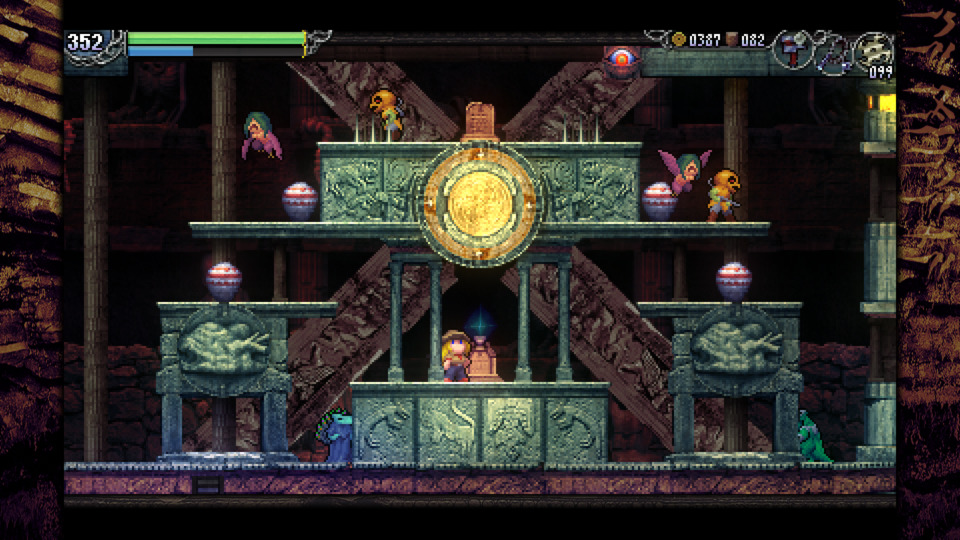
It's a puzzle that relies mostly on spatial awareness and experimentation, though you get a nice big hint in the central room for two of the bosses: the "witch" Scylla and the Griffin, met in the first and third rotations respectively. Due to the nature of the game, though, you'd also need to learn about four or five other pieces of information to make any headway at all, including the mantra needed to shift the disc in the first place. Read everything, talk to everyone; usual rules apply.
3) The White-Knuckle Gauntlet of Echidna
So, completing the main objective of Heaven's Labyrinth gets you into the Hall of Malice, where Echidna and her children have been frozen in time as a means to prevent their rampage across the rest of Eg-Lana. In Greek mythology, Echidna and her husband Typhon (who in La-Mulana 2 is actually the ancient supercomputer built to keep tabs on her) were responsible for birthing almost every monster (barring the few the Gods themselves had a hand in, like Medusa) but here there's only eleven. That does mean fighting all eleven before Echidna becomes available to battle, whom herself is one of the game's toughest bosses best left well into the late-game.
The Hall of Malice bucks some of the rules for the sake of increasing its challenge, as it's meant to be something of a boss rush. On your first visit, everything's frozen in time just as the Olympians left it: the player needs to find an artifact left over from a previous race to restart everything, at which point they can take one of three routes: each requires you fight three bosses in a row before you're allowed to return back to the entrance and rest, as the ultra-reliable Holy Grail fast-travel item is initially disabled. The other two bosses can be fought on their own if need be, but since they're also the two easiest the game's not really doing you a big favor taking them out of the rotation.

Granted, this gauntlet isn't really a puzzle or much of a mystery, but it is an example of how La-Mulana 2 will occasionally remind you that it's also meant to be a balls-hard Castlevania type of action game on top of one full of riddles to solve and ancient texts to analyze for hints. That said, finding the item needed to revive everything and then figuring out how to beat those bosses as efficiently as possible so you're not carrying too much damage into the second and third encounters on any given route are also key to the game's process of learning through experimentation and revisiting zones with new knowledge and items.
4) The Dark Star Lord's Footprints
This one really took some time to sink in because it deals with La-Mulana/Eg-Lana's biggest mystery of all: Who were the Annunaki, also known as the Sky People, that both the 1st and 2nd Children encountered? Building on the real-life theories (though not ones that hold a whole lot of water) that civilization was brought to the ancient humans by a race of extra-terrestrials who may have had altruistic or entirely selfish reasons for elevating our primitive species, the Annunaki are an alien race of vaguely humanoid greys who sought to conquer Earth and plunder its resources for their own gain. Encountering Mother, a being far beyond their ability to combat directly, they worked with its slave races to undermine Mother and quietly developed their own technology to bind it. However, in the process, they were all defeated and their ship left to hover somewhere in orbit undetected for many thousands of years. Figuring out their secrets - in particular, the plan they had in mind to rob Mother of its strength - is an essential thread in both La-Mulana games.
What I love about the Annunaki is that they're complete dicks. There's a set of collectibles that resemble crystal skulls that offer no real purpose for much of the game, but since there's twelve of them total you'll often complete a puzzle and open a chest just to find another one of these Dan Aykroyd-ass paperweights instead of an actually useful HP upgrade or a traversal item that might unlock whole new sections of dungeon to visit. You'll eventually acquire an app that can translate data installed inside these skulls, but they rarely reveal anything useful: mostly insults hurled at the Mother or its Children, while espousing the glory of the Annunaki. Very much the same attitude you'd get from the Mooninites of Aqua Teen Hunger Force fame. That their technology and deviousness are advanced enough to offer the key to your predicament is something of an embarrassment to the human race, who are still cavemen in comparison.
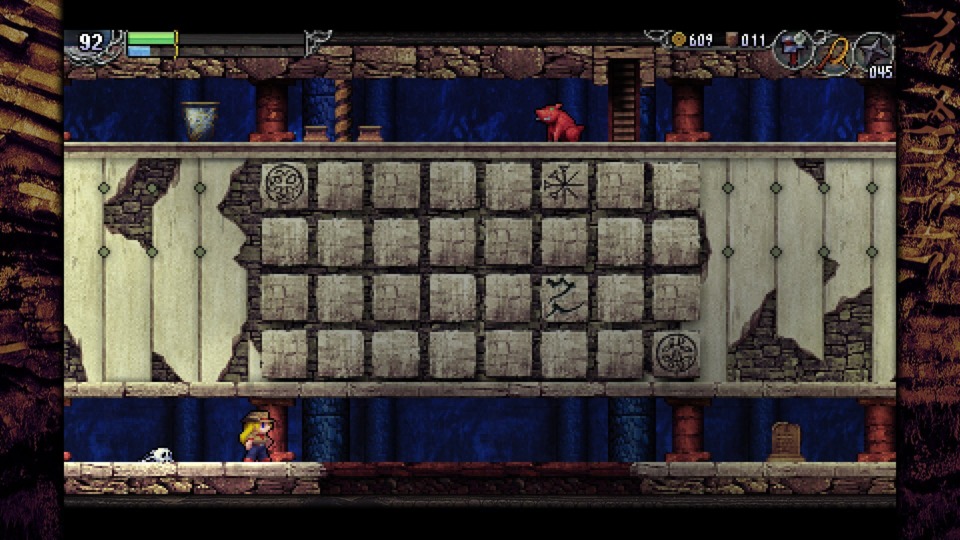
To access their orbital mothership you need to solve the riddle of the Dark Star Lord (the 5th Children's name for the aliens and their leader, Anu, which they learned from scouring what few records remained of the 1st and 2nd) via their Mausoleum, a late-game area that requires solving the puzzles of a place that flipped its gravity every time you went through a door (it's a real annoying place to explore, as you might imagine). This in turn requires two key items found elsewhere in the game, knowing all the mantras required to activate the platform to use said items, and a game-wide hint system that resembles a bunch of those NES Mega Man password grids with specific symbols on them that tell you what those mantras are. Hilariously, you can then enter their mothership and immediately die from the lack of oxygen: another problem you need to solve before you can properly learn their secrets, and that's after the two instant-death traps on the route up. Like I said, the Annunaki are dicks.
5) The Seven Gates of the Underworld
There's at least two access points to the Underworld, known in-game as the Eternal Prison, besides the most direct and painful way (and that won't actually help you, since dying forces you to reload). However, neither of them are easy to find nor easy to open. The first has you entering via the eerie Corridor of Blood network, which means removing a seal that Izunaga of the 1st Children put into place to prevent anything in there from escaping (his rotting former wife, Izanami, most of all) while the other involves emptying the right pool of poison lava and fighting a ten-meter-long dragon guardian in a room with even more poison lava pools. You'd also need the right mantra to get in there.
However, the biggest issue when exploring the Eternal Prison is how reaching its boss works. There are two "sides" - amusingly titled Doom and Gloom - and every time you use a gate to pass through one side to the other you lose one of your traversal items, starting with the Holy Grail (so no fast-travelling out) and going through a set order of seven that eventually includes your double-jump, your wall-climbing gloves, and the suit that makes you resistant to lava, which - as you might expect - is everywhere down there. There's also false gates, which won't take the right item next in the order and will therefore put you out of sync; warp gates, which kick you out of Eternal Prison entirely instead of letting you explore further, though they at least provide the benefit of an easy means of escape; The Last Gate, which kills you instantly if it's not actually the last one you go through; and very occasionally a gate will warp you into a doppelganger boss fight that will also kill you instantly if you haven't learned the trick to beat it from the right tablet. Also, at least one of these gates needs to be revealed first, done by completing an entirely different set of puzzles. Also, also, if you don't have the specific item a door is meant to remove from your inventory, you just die instead - thus, you can't start the "Underworld Door Tour" until you have all seven of the traversal items it's obligated to take from you.
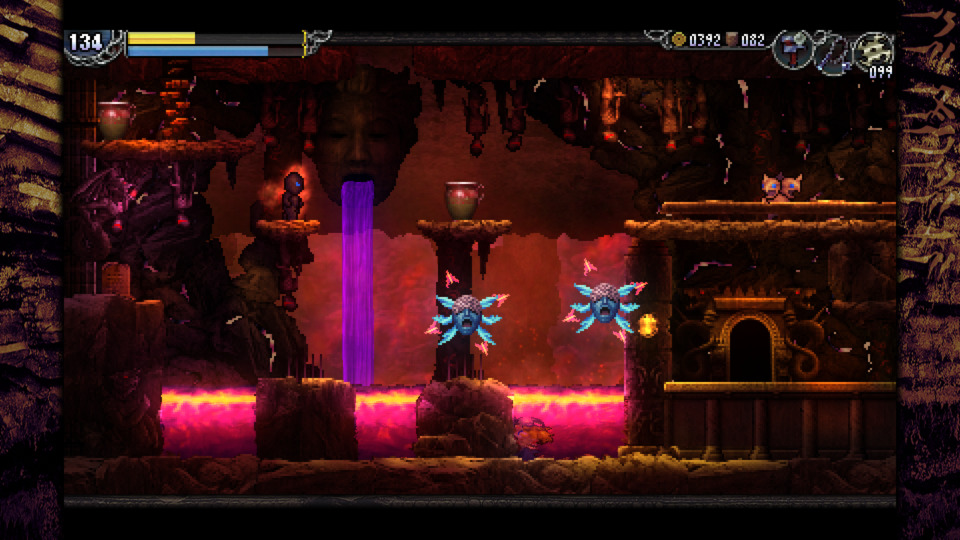
The smart aspect of this puzzle is that, if you eliminate all the false and warp gates, most of the "true" ones usually require some mix of those traversal items to reach. One such example is behind a couple of columns which you can only get around with the claw. Another is behind a purple forcefield, which requires the heavy resistance suit to pass through safely. By looking around beforehand and taking careful notes of which doors require what items to reach, you can intuit the correct order you're meant to pass through them. It does mean thoroughly exploring both sides of Eternal Prison, which is no mean feat on its own as it's easily one of the most challenging places to pass through. Gee, you'd think they'd make Hell easier.
6) The Trials of Brahma
I really had to think hard about this one, and I later learned that it isn't even required to complete the game or your collection of traversal upgrades and other key items. The only reward you get is learning where all the remaining unfound crystal skulls (needed for the Dark Star Lord's path, above) and the murals (from which you get the mantras; some of which actually require invoking other mantras to reveal). It's a handy tool to have if you're trying to find needles in a haystack towards the game's final hours, but it's almost more trouble than it's worth.
Brahma, along with its peers Vishnu and Shiva, are depicted here as massive computers installed by one of the earlier Child races as a means to keep tabs on the Eg-Lana compound as a whole. However, it needs to be activated first: to do that, you have to solve a riddle regarding the four Hindu Yuga, or world ages. This means finding the right eight tablets scattered all over Eg-Lana - one set tells you the colors of the four Yugas, while another tells you two aspects of that age - and then use the right key item on background statues of creator deities from other mythologies that Brahma consulted on the meaning of creation. Each aspect has their own colors coded to them also, and are represented by a set of lasers that you're meant to shine on the podia that represent the four ages. By shining the correct lights on the correct podia under the correct conditions, you unlock the enhanced map functions.
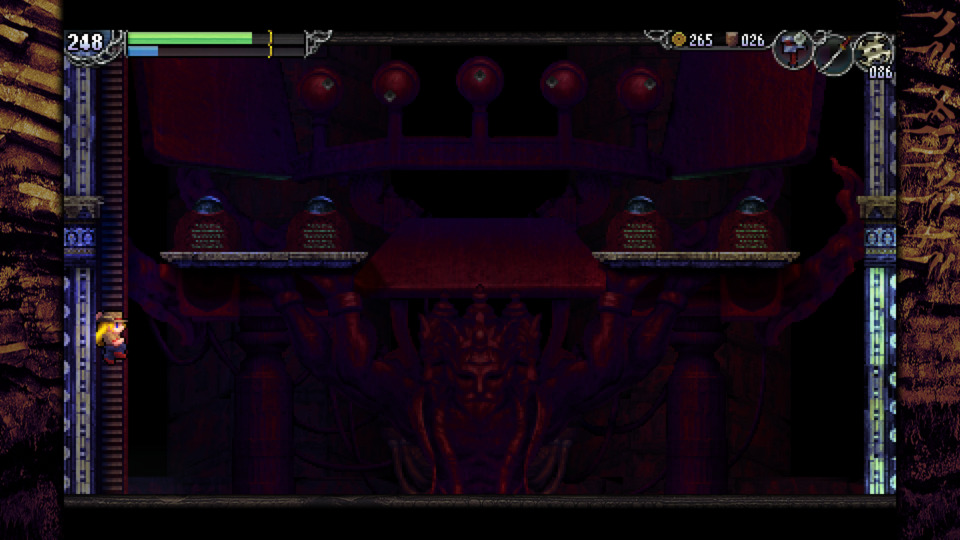
My only advice here is to record absolutely any mention of Brahma while exploring the rest of the game, because this puzzle has at least a dozen pieces of pertinent information and they're all required to solve it. Not really something you can brute force, that's for sure. Hell, you might find all the skulls and mantras incidentally in the process of hunting down all the necessary hints.
7) The Corridor of Blood
I mentioned the Corridor above when talking about Eternal Prison, which exists as a sort of fast-travel system that lets you access six different destinations across Eg-Lana, three of which initially can't be accessed any other way. The Corridor of Blood makes no logical or geographical sense even with the strange and often magical rules of Eg-Lana and appears to exist in a dimension outside of regular space. I liken it to the hyperspace dimension of Star Control II: itself a game with a whole lot of mysteries to delineate.
Naturally, it turns out that The Corridor of Blood was installed by the Annunaki (those jerks again!) and is part of their grand scheme to trap Mother and remove her powers. According to the game's lore, it's able to channel dissonance across and around Eg-Lana - the negative energy caused by the in-fighting of all the Children races - and with enough of it, is able to punch a hole through to Eg-Lana's core where its soul is waiting. This is the means through which you are able to complete La-Mulana 2, though gathering the amount of dissonance required means resolving every other major puzzle first (and some sources aren't so obvious; like gathering the dissonance generated from the conflict between the tribes of the 2nd Children despite the fact they're meant to be extinct).
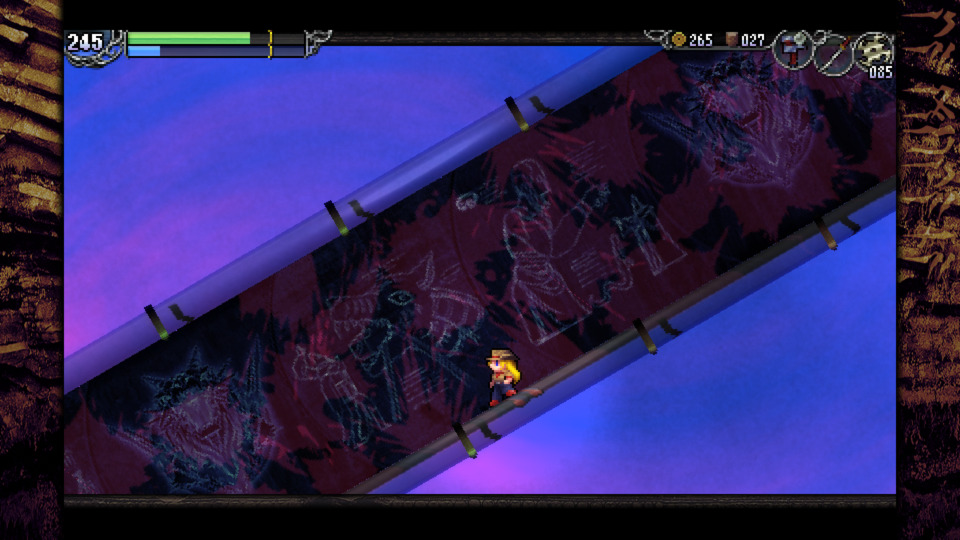
I'm a fan of the idea of taking something that appears to exist purely as a convenience for players - we don't often question why fast-travel is a thing in-universe, except as a means to make the game more enjoyable to play via the utility it offers - and turning it into something vital to the resolution of the game's narrative. To make this odd little system of glass tubes running through what appears to be a trippy, kaleidoscopic void (like those seen in EarthBound battles) a crucial component of the game's final and biggest puzzle is another "hiding in plain sight" masterstroke akin to the Seeress tablets.
The End!
My hope is that if you haven't tried La-Mulana or don't understand its fearsome reputation, you clocked a fraction of the wall of insanity above and figured you owed it yourself to learn about the rest first-hand. Or you're a fellow La-Mulana 2 survivor and are vividly recalling how obtuse this all felt at the time with what I hope is only a mild case of PTSD. Either way, I wanted to give La-Mulana 2 the props it deserves for just how deeply layered its esoteric nonsense can get, and to some extent how its designers' in-depth studies of world religions and mythologies are cleverly represented by the game's riddles. The archeology-related puzzles of Uncharted or Tomb Raider have absolutely nothing on La-Mulana - you can't just push a box around for five minutes until you can intuit a solution here, though you can certainly get yourself squished by one; rather, you really have to be paying attention throughout. While also dying a lot, since this game has more sudden-death traps than a Kaizo ROM hack.
As I said in a mini-review elsewhere, while there are plenty of games that provide a level of satisfaction when you finally beat them there are precious few that make you feel like you've undergone a rite of passage and come out the other side a changed person: La-Mulana 2 is one of them, for better or worse. I'm evidently going to have to return to the first one someday, even if I already know all the big twists (which now you all know too, so... oops?).
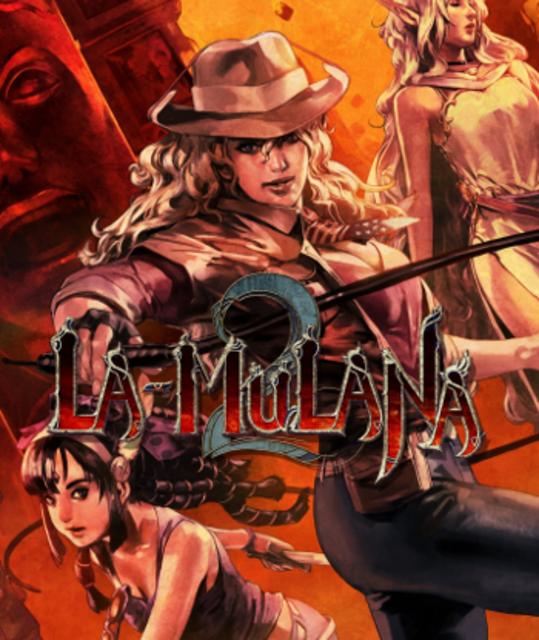
Log in to comment